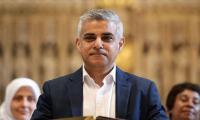KARACHI: Rupee fell another 1.4 percent on Monday, slumping for a second day, after the central bank apparently allowed market-based adjustments in the currency and analysts believe it may slide even further in the near-term to help arrest the country’s falling exporters.
Rupee closed at 108.41 to a dollar, which was far its previous low of 107 in the interbank market. In morning, the rupee even touched 109.25/dollar.
Traders and currency analysts said rupee tumbled in an ‘apparent’ devaluation by the central bank.
“This is calculated devaluation on SBP’s (State Bank of Pakistan) part,” a head of treasury at a bank said. “Indications are (that) the same had been agreed in the post program analysis meeting with IMF (International Monetary Fund) last week.”
But, the SBP reiterated its previous stance of market-based adjustments in the exchange rate.
“A continuous depreciation in the rupee is market-determinant,” a central bank’s source said. “It’s nothing to do with the currency devaluation.”
Currency dealers threw their weight behind the central bank’s argument, saying it was a move towards a ‘flexible regime’.
“The rupee is trading independently as per demand and supply mechanism,” a dealer said. “It’s likely to settle down around 110 in next few days.”
Analyst Eman Khan at Tresmark, a financial terminal for market rates, said the rupee devaluation might be in line with the demand of IMF, which has always advocated a flexible regime.
“What’s more important is to see whether the trend will continue once the review meetings conclude,” Khan said. “However, the timing is a bit unfortunate as we’ve just floated Eurobond and no investor likes uncertainty.”
She further said the Monday’s fluctuation was very high “that creates more panic in the market”.
Various estimates said rupee should be around 115 to 120.
“The market is expected to consolidate under 110 in the short-term but based on demand and supply, the rupee could devalue further,” another analyst said.
“Judging by the statement of SBP, they intend to let the market decide the true value of the rupee so the next few trading sessions will be quite interesting.”
The banker said it seems like there will be bursts of calculated daily or weekly devaluation in the market with SBP keeping a close watch on volatility.
Rupee traded at close to Rs105/dollar since late 2015 even the currency had no official peg.
Government has so far adopted a strong rupee policy and converted the regime into an almost-fixed exchange rate one that caused drop in exports and remittances.
A former central bank’s governor said the authorities have been forced to let the rate depreciate a bit because of a massive loss in reserves and insistence of the IMF and the World Bank.
“But still the rate remains overvalued to the extent of about 15 percent,” Muhammad Yaqub, ex-governor SBP said. “It is wrong to assert that the rate is market determined. It moves only when the SBP gives signal to the market and that also to the extent dictated by the Ministry of Finance.”
He said overvalued exchange rate discouraged exports, encouraged imports and kept the rupee cost of foreign debt servicing below what it should be under an appropriate level of the rate of exchange. “The recent rate change will have minimal impact either on imports or on exports because the rate is still substantially overvalued.”
Yaqub said a partial rate correction will increase the rupee cost of foreign debt payment, “but the government will still enjoy an implicit subsidy in its expenditure on foreign debt payment due to the remaining overvaluation”.
“The increase in rupee debt payment cost should be treated as a partial reduction in the subsidy to the government rupee expenditure on foreign debt payment through an overvalued exchange rate,” he added.
Systems Limited, IT and IT-enabled services provider, hosted US Ambassador to Pakistan Donald Blome on May 3, 2024....
The logo of the Telenor Microfinance Bank . — temenos websiteKARACHI: Telenor Microfinance Bank reported a strong...
Chief Executive TDAP Mr. Zubair Motiwala met with HE Dr. Bakheet Ateeq Al-Remaiti, Consul General of UAE, in Karachi...
A representational image of gold bangles. — AFP/FileKARACHI: Gold prices in the local market dropped by Rs1,400 per...
A person walks by a sign advertising employment at a fast-food restaurant in New York City. — AFP FileWASHINGTON:...
This picture taken on January 30, 2023 shows residents buying vegetable at a market in Karachi. — AFP/FileLAHORE:...







